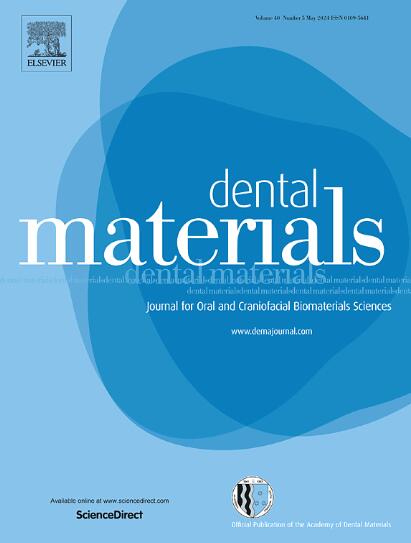探索 CAD-CAM 树脂基复合材料、聚合物浸润陶瓷网络和长石瓷的光学行为和相对透光参数。
IF 4.6
1区 医学
Q1 DENTISTRY, ORAL SURGERY & MEDICINE
引用次数: 0
摘要
目的:评估和比较 CAD-CAM 修复材料的光学特性和相对半透明参数:评估和比较 CAD-CAM 修复材料的光学特性和相对半透明参数:评估了四种 CAD-CAM 材料:方法: 评估四种 CAD-CAM 材料:Lava Ultimate (LU)、Grandio Blocs (GB)、VITA Enamic (VE) 和 VITA Mark II (VM)。制备了色调为 A2-HT 的圆盘状样品(n = 10),并抛光至厚度为 1.00 ± 0.01 毫米。散射 (S)、吸收 (K)、反照率 (a) 系数、透射率 (T%)、光反射率 (RI)、无限光学厚度 (X∞) 和辐射传递系数 (μa 和 μ'S) 均采用 Kubelka-Munk 方法和 Thennadil 半经验方法计算。均方根误差(RMSE)和拟合优度(GFC)被用作性能光学行为。使用相对半透明参数(RTP00)和 50:50 % 半透明可感知性和可接受性阈值(TPT00 和 TAT00)评估半透明差异:S、K、T%、RI 和 X∞ 的光谱分布与波长有关。GFC 和 RMSE 值表明,LU-GB、LU-VE 和 GB-VE 中的 RI 以及 VE-VM 中的 K 具有良好的光谱行为匹配和光谱比较值。VM 在所有波长上的散射值最高,而 VE 和 VM 在较短波长上的吸收值较低。LU 和 GB 的透射率最高。X∞ 值表明,所有 1.0 毫米厚的材料都可能受到背景的影响。CAD-CAM 材料和牛上颌前部标本之间没有发现良好的光谱匹配和光谱比较值。与所评估的 CAD-CAM 材料相比,VM 的 RTP00 值最低,且存在可感知和不可接受的差异:意义:了解不同 CAD-CAM 材料的光学特性对于指导临床医生选择材料和优化其临床表现至关重要。研究结果证实,不同的成分和微观结构会影响 CAD-CAM 修复材料的光学特性和透光性。本文章由计算机程序翻译,如有差异,请以英文原文为准。
Exploring the optical behavior and relative translucency parameter of CAD-CAM resin-based composites, polymer-infiltrated ceramic network, and feldspar porcelain
Objectives
To evaluate and compare the optical properties and relative translucency parameter of CAD-CAM restorative materials.
Methods
Four CAD-CAM materials were evaluated: Lava Ultimate (LU), Grandio Blocs (GB), VITA Enamic (VE), and VITA Mark II (VM). Disk-shaped samples in shade A2-HT were prepared (n = 10) and polished to 1.00 ± 0.01 mm of thickness. Scattering (S), absorption (K), albedo (a) coefficient, transmittance (T%), light reflectivity (RI), infinite optical thickness (X∞), and radiative transfer coefficients (μa, and μ′S) were calculated using Kubelka-Munk method and Thennadil's semi-empirical approach. Root Mean Square Error (RMSE) and Goodness of Fit (GFC) were used as performance optical behavior. Translucency differences were evaluated using the relative translucency parameter (RTP00) and 50:50 % translucency perceptibility and acceptability thresholds (TPT00 and TAT00).
Results
The spectral distribution of S, K, T%, RI, and X∞ was wavelength-dependent. GFC and RMSE values indicated good spectral behavior matches and good comparative spectral values for RI in LU-GB, LU-VE, and GB-VE, and for K in VE-VM. VM displayed the highest scattering values across the wavelengths, while VE and VM showed lower absorption at shorter wavelengths. LU and GB had the highest transmittance. The X∞ values indicated that all 1.0 mm thick materials could be influenced by the background. No good spectral match and no good comparative spectral values were found between CAD-CAM materials and anterior bovine maxillary specimens. VM had the lowest RTP00 values with perceptible and unacceptable differences compared to CAD-CAM materials evaluated.
Significance
Understanding the optical behavior of different CAD-CAM materials was essential for guiding clinicians in material selection and optimizing their clinical performance. The findings confirm that the different compositions and microstructure impact the optical properties and translucency of CAD-CAM restorative materials.
求助全文
通过发布文献求助,成功后即可免费获取论文全文。
去求助
来源期刊

Dental Materials
工程技术-材料科学:生物材料
CiteScore
9.80
自引率
10.00%
发文量
290
审稿时长
67 days
期刊介绍:
Dental Materials publishes original research, review articles, and short communications.
Academy of Dental Materials members click here to register for free access to Dental Materials online.
The principal aim of Dental Materials is to promote rapid communication of scientific information between academia, industry, and the dental practitioner. Original Manuscripts on clinical and laboratory research of basic and applied character which focus on the properties or performance of dental materials or the reaction of host tissues to materials are given priority publication. Other acceptable topics include application technology in clinical dentistry and dental laboratory technology.
Comprehensive reviews and editorial commentaries on pertinent subjects will be considered.
 求助内容:
求助内容: 应助结果提醒方式:
应助结果提醒方式:


